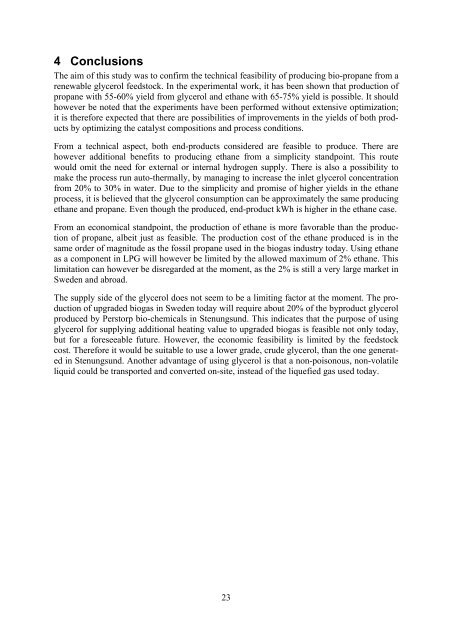Rapport SGC 198 Bio-Propane from glycerol for biogas addition
Rapport SGC 198 Bio-Propane from glycerol for biogas addition
Rapport SGC 198 Bio-Propane from glycerol for biogas addition
- No tags were found...
You also want an ePaper? Increase the reach of your titles
YUMPU automatically turns print PDFs into web optimized ePapers that Google loves.
4 ConclusionsThe aim of this study was to confirm the technical feasibility of producing bio-propane <strong>from</strong> arenewable <strong>glycerol</strong> feedstock. In the experimental work, it has been shown that production ofpropane with 55-60% yield <strong>from</strong> <strong>glycerol</strong> and ethane with 65-75% yield is possible. It shouldhowever be noted that the experiments have been per<strong>for</strong>med without extensive optimization;it is there<strong>for</strong>e expected that there are possibilities of improvements in the yields of both productsby optimizing the catalyst compositions and process conditions.From a technical aspect, both end-products considered are feasible to produce. There arehowever <strong>addition</strong>al benefits to producing ethane <strong>from</strong> a simplicity standpoint. This routewould omit the need <strong>for</strong> external or internal hydrogen supply. There is also a possibility tomake the process run auto-thermally, by managing to increase the inlet <strong>glycerol</strong> concentration<strong>from</strong> 20% to 30% in water. Due to the simplicity and promise of higher yields in the ethaneprocess, it is believed that the <strong>glycerol</strong> consumption can be approximately the same producingethane and propane. Even though the produced, end-product kWh is higher in the ethane case.From an economical standpoint, the production of ethane is more favorable than the productionof propane, albeit just as feasible. The production cost of the ethane produced is in thesame order of magnitude as the fossil propane used in the <strong>biogas</strong> industry today. Using ethaneas a component in LPG will however be limited by the allowed maximum of 2% ethane. Thislimitation can however be disregarded at the moment, as the 2% is still a very large market inSweden and abroad.The supply side of the <strong>glycerol</strong> does not seem to be a limiting factor at the moment. The productionof upgraded <strong>biogas</strong> in Sweden today will require about 20% of the byproduct <strong>glycerol</strong>produced by Perstorp bio-chemicals in Stenungsund. This indicates that the purpose of using<strong>glycerol</strong> <strong>for</strong> supplying <strong>addition</strong>al heating value to upgraded <strong>biogas</strong> is feasible not only today,but <strong>for</strong> a <strong>for</strong>eseeable future. However, the economic feasibility is limited by the feedstockcost. There<strong>for</strong>e it would be suitable to use a lower grade, crude <strong>glycerol</strong>, than the one generatedin Stenungsund. Another advantage of using <strong>glycerol</strong> is that a non-poisonous, non-volatileliquid could be transported and converted on-site, instead of the liquefied gas used today.23
















